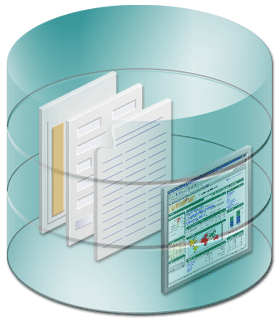|
|
Administration Made Easy Oracle Portal's architecture and Web-based design offer many advantages to you, the portal or database administrator, including simplicity of installation, distribution of non-administrative tasks, and a full-featured administration environment accessible anywhere through a Web browser. In this section of the Quick Tour, you will learn about the Oracle Portal features that provide this ease of administration.
Oracle Portal Architecture Overview Oracle Portal is designed around a proven three-tier architecture that fits your organization no matter how large or small.
You can scale the product to fit your organization as it grows by distributing Oracle Portal across multiple instances of the database (referred to as nodes). When you run out of space, or start to experience performance problems, simply add another node and migrate some of your content or data to that node. Distributed Oracle Portal also enables you to consolidate different sources of content into a single portal. Leverage the Power of the Oracle Database From an administrative point of view, Oracle Portal's most powerful advantage is that it is contained entirely within the Oracle 8i database. Thus, you can take advantage of the reliability, scalability, and availability offered by 8i's enterprise-class power. Plus, any performance enhancements made for the database, such as more memory or configuration tuning, automatically apply to Oracle Portal. 
In addition, all content and applications created using Oracle Portal are also stored in the database, providing huge maintenance benefits. For example, if you want to back up all your data, applications, and content, simply back up the database. That takes care of it all in a single step. Having everything—product, data, applications, and content—stored in the database also means that you benefit from centralized administration. All your administrative tasks can be performed within the same environment, using the same tools. As mentioned previously in this Quick Tour, Oracle Portal is completely Web-based—everything takes place within a standard Web browser, such as Netscape Navigator or Microsoft Internet Explorer. As the administrator of Oracle Portal, this offers you a couple of significant benefits. The first benefit is that the only thing your users need to install on their client machines is a browser. And chances are they already have one installed. There's no additional, complicated, expensive software to install, support, or upgrade, making it extremely simple and cost-effective to get your users up and running. The second benefit is that all Oracle Portal's administrative features are accessible through a browser too. As a result, you are no longer tied to a particular location to carry out your job. Wherever you are, simply start up your browser and connect to Oracle Portal. Easy Installation and Configuration Installation is made simple with the aid of the easy-to-use install wizard, which guides you step-by-step through the installation process. Oracle Portal uses the Oracle Universal Installer for installation, which also includes a configuration assistant that helps you create your Oracle Portal environment, making it much easier to perform multiple installations of Oracle Portal across different databases. After installation is completed, Oracle Portal provides all the tools you need to create user accounts, grant those users access to other user, administrative, and development tools, and configure search, gateway, and other global settings. Track User Activity and Monitor Performance Ever wanted to find out exactly what your users do when they use your portal? Or uncover and resolve problems with your system before your users even report them? Well, now you can.
In addition, database administrators can access a set of monitoring tools that provide information about the database in which Oracle Portal is installed, including storage, sessions, and memory utilization. Database administrators can use this information to monitor the performance of the database, and quickly identify potential problems. In today's global working environment, chances are that you need your applications and information to be available in many different languages. Oracle Portal is available in over 20 different languages—and there's no need to buy localized versions; it's all there in the same box. When you deploy Oracle Portal in a different language, users can set their browser language preference appropriately to see wizards, dialog boxes, messages, and other non-user defined text in that language. Oracle Portal does not automatically translate your content for you, but content area administrators can enable content contributors to add an item in multiple languages in the same content area. There's no need to create a different content area for each language; each user automatically sees the content in the language defined in their browser preferences (if the content has been added in that language). |
||||||||||||||
|
Copyright
© 1995, 2000 Oracle Corporation.
All Rights Reserved. |